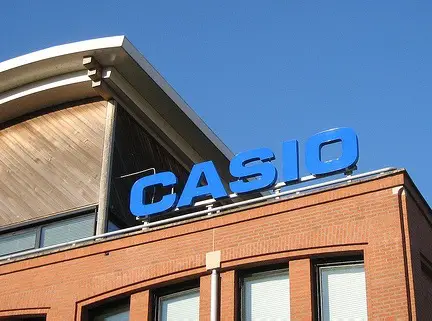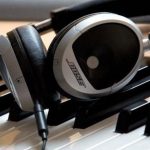
Casio was doing quite well with their calculator business when in the late 1970s, it decided to cater to the musically inclined as well. Since then Casio has inspired an electronic music revolution. Casio was successfully able to turn its calculator expertise into synthesizer/music keyboard success.
Highlights
- In 1980, Casio launched the first digital keyboard – Casiotone 201
- In 2003, Casio launched the Privia range of affordable digital pianos
- In 2007, Casio introduced “Indian High-Grade Keyboards” (such as the CTK-810IN)
- Casio has now revived the Casiotone Series, with a new design and smartphone application
History of Casio
 Casio is an electronics manufacturing giant, headquartered in Tokyo, Japan. It was founded in 1946, though their synthesizer keyboards were introduced somewhere in the eighties.
Casio is an electronics manufacturing giant, headquartered in Tokyo, Japan. It was founded in 1946, though their synthesizer keyboards were introduced somewhere in the eighties.
In fact, their Casiotone range of keyboard instrument was first released in 1980. These were small keyboards with tiny keys designed mostly for children’s fingers, and not for any professional use, though the sounds were pretty good. In terms of features, you would get a rhythm generator, and several rhythm patterns, and buttons to play the various accompaniments.
The various tones in any electronic keyboard are produced using various synthesis methods. The earlier Casio keyboards used a sound synthesis technique known as Vowel-Consonant synthesis, to produce the sound of the various instruments.
Over the years however, PCM sample based tone generator became more dominant in the Casio product line. Post 1990s, the majority of Casio keyboards would use PCM tone generator or its variants, to produce the various instrument sounds.
Even the name “Casiotone” disappeared from their product catalog as more accurate synthesis technologies became prevalent. However, their low cost and good marketing strategy ensured that you could find Casio keyboards in abundance and made them fairly common fixtures in garage rock bands.
Some of Casio’s current keyboard series, such as the CTK, have being in existence for several years now!
- In 1980, Casio introduced the Casiotone that was appreciated by music lovers. Then came the VL-1, a miniature keyboard with memory capacity, the CZ-101, a powerful digital synthesizer, and the SK-1 sampling keyboard with 32 mini keys, four-note polyphony and a built-in microphone. By 1988, Casio’s product portfolio also included the DG-series digital guitars and the DH-100 electronic wind instrument, besides keyboards.
- In the early 2000s, Casio introduced the PRIVIA range of portable digital pianos that featured sophisticated keyboard touch and authentic timbre, and became quite popular with music lovers. The latest PRIVIA digital pianos include the PX-S1000 and PX-S3000 (the ‘S’ stands for slim).
- In 2013, Casio released the PRIVIA PX-5S stage piano within the PRIVIA line, that included a comprehensive feature-set for professional musicians – Hex Layer synthesis engine with tone editing, MIDI controller functionality, extensive DSP effects, and more.
- In 2015, Casio introduced the CELVIANO Grand Hybrid digital piano series to cater to the more demanding piano players; these pianos deliver authentic vertical grand piano hammer movement.
Casio Melody-80
In 1979, the Casio Melody-80 was launched; it was a calculator with a built-in stopwatch and an alarm clock. But more importantly, it could work as a musical instrument as well. Like a synthesize, the Melody-80 had pre-programmed classical music that could be easily played back, you could also play musical notes.
“By flicking the upper right-hand switch, you convert its calculator buttons into music keys, a full 11 note scale from A to D.”
With the success of the device, Casio decided to enter into the electronic music market.
Focus on Beginners & amateurs
Toshio Kashio, one of the Japanese brothers who founded Casio was an amateur musician and wanted amateur musicians to have access to an entire world of instruments.
And that is why Casio’s approach towards musical instruments was different from other major music instrument companies, say Moog.
So instead of building a device that played with waveforms (like Robert Moog did), Casio decided to make a single device that could let you play dozens of instruments—including a drum beat, guitars, and melodies (it appealed to the masses).
Early Synthesizers from Casio
Several synthesizers that Casio introduced at that time could be considered as toys, like the Casio VL-Tone, which was used in Trio’s “Da Da Da.”
However in 1980, Casio released a serious (sort of) music synthesizer – the wood-encased Casiotone 201 with sound banks that could play an electric guitar, a banjo, a harpsichord, a trumpet, and even a glockenspiel.
Although this was a big step forward for Casio, unfortunately the product did not do very well. But the good thing was that professional musicians saw value in the instrument…they had access to a new palette of sound with which they could play.
Useful Links
How Casio accidentally started reggae’s digital revolution
Noel Davey used a pattern on the Casio MT-40 keyboard to create the the first fully computerised riddim in Jamaican music: the ‘Sleng Teng’
Casio Promoted their Keyboards in America
Casio’s sound-bank style keyboards came quite handy to do a great sales pitch. It was good for Casio’s image, as many felt that this product was much cooler than calculators. Casio knew they had a winner in hand and started marketed them aggressively.
“Finally, a musical instrument that could let ‘you be your own band’ was born.”
Checkout these Casio Keyboard Commercials in 1985 & 1986
Following the Casiotone series, Casio made keyboards like the CZ series, Rapman, and a few other toy keyboards.
Casio Keyboards Used by Popular Bands
Watch Dan Deacon performing a live song. Can you spot the Casio MT-400V (most powerful Casiotone ever made) on his table full of music gear? The MT-400V came with several effects, including an analog resonance filter, noise generator, and stereo chorus effects.
“A nice Casiotone is always an endless mammoth of sound that can be fun, especially the MT-400V, which is the one that I’ve been using for the longest and that’s my favorite piece of gear that I have,” said Dan during the release of his first commercial album.
Checkout this video of Jimmy Fallon, Metallica, and The Roots playing “Enter Sandman” on classroom instruments. Can you spot the Casio VL-Tone, used to keep time?
KeytarHQ editorial team includes musicians who write and review products for pianists, keyboardists, guitarists & other musicians. KeytarHQ is the best online resource for information on keyboards, pianos, synths, keytars, guitars and music gear for musicians of all abilities, ages and interests.



Leave a Reply